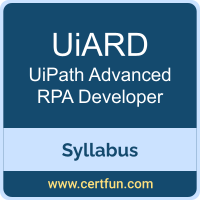 Use this quick start guide to collect all the information about UiPath UiARD Certification exam. This study guide provides a list of objectives and resources that will help you prepare for items on the UiPath Advanced RPA Developer (UiARD) exam. The Sample Questions will help you identify the type and difficulty level of the questions and the Practice Exams will make you familiar with the format and environment of an exam. You should refer this guide carefully before attempting your actual UiPath Certified Advanced RPA Developer (UiARD) certification exam.
Use this quick start guide to collect all the information about UiPath UiARD Certification exam. This study guide provides a list of objectives and resources that will help you prepare for items on the UiPath Advanced RPA Developer (UiARD) exam. The Sample Questions will help you identify the type and difficulty level of the questions and the Practice Exams will make you familiar with the format and environment of an exam. You should refer this guide carefully before attempting your actual UiPath Certified Advanced RPA Developer (UiARD) certification exam.
The UiPath UiARD certification is mainly targeted to those candidates who want to build their career in RPA Developer domain. The UiPath Certified Advanced RPA Developer (UiARD) exam verifies that the candidate possesses the fundamental knowledge and proven skills in the area of UiPath UiARD.
UiPath UiARD Exam Summary:
| Exam Name | UiPath Certified Advanced RPA Developer (UiARD) |
| Exam Code | UiARD |
| Exam Price | $200 (USD) |
| Duration | 120 mins |
| Number of Questions | 90 |
| Passing Score | 70% |
| Schedule Exam | Pearson VUE |
| Sample Questions | UiPath UiARD Sample Questions |
| Practice Exam | UiPath UiARD Certification Practice Exam |
UiPath UiARD Exam Syllabus Topics:
| Topic | Details |
|---|---|
| UiPath Studio |
- Identify and describe how UI Automation activities and/or Excel activities (Classic design experience) can be configured to interact with background windows - Describe how to use state machines versus flowcharts and sequences - Describe how to use and configure Activity Project Settings and Classic Libraries |
| UiPath Studio – Activities and Properties |
- Identify and describe how activities are used to automate actions in Excel, e-mail, and .pdfs - Differentiate between input methods in the Classic design experience - Identify and describe the key Classic UI Activities' properties; for example, ContinueOnError, DelayBefore, DelayAfter - Describe the use of various Classic UI synchronization activities; for example, Element Exists, Find Element, Find Text - Identify and apply how to extract structured data from an application in UiPath Studio using the Classic design experience - Understand how to build attended automation using the Background Process template, Studio Triggers, and Picture in Picture (PiP) |
| UiPath Studio – Robotic Enterprise (RE) Framework |
- Understand how to build automation processes using the REFramework template with Orchestrator queues - Modify the REFramework to use any datatype for TransactionItem; for example, String, DataRow, etc. - Modify the REFramework template to accommodate any type of process; transactional, linear, iterative - Describe the differences between Dispatcher and Performer, how the Dispatcher is used to upload transaction items, and how the Performer is used to consume the queues and process the transactions - Differentiate between using the Settings sheet and the Assets sheet in the configuration file - Differentiate between using Application Exceptions and Business Rule Exceptions - Understand and describe the new REFramework 2021.10 features |
| Classic Selectors |
- Determine and describe how robust selectors are created; for example, dynamic versus static selectors - Describe how Tags and Attributes, Dynamic Selectors, Anchor Base, etc. are used in UI Explorer to create a robust selector in the Default, Active Accessibility, or UI Automation frameworks - Describe the differences between using full selectors versus using partial selectors |
| .NET Classes and Objects |
- Identify how methods, activities, and the RegEx Builder are used for string manipulation and regular expressions - Describe how to work with complex data structures and data manipulation; for example, datatables, lists, dictionaries - Describe how to initialize variables such as lists and datatables, and how to filter datatables - Explain how to use the VB Invoke Code, Invoke Method, and Invoke Workflow activities and how arguments are used to pass data |
| Advanced Functions |
- Identify and describe UiPath coding best practices - Understand how GIT is used for version control - Describe the functionality of the Workflow Analyzer and how to use or customize existing rules |
| Error Handling and Troubleshooting |
- Identify and describe the use of the error handling activities such as Try Catch, Throw, Rethrow, Retry Scope, and Global Exception Handler - Examine and describe the activities and/or features used to troubleshoot and debug projects - Describe how to write coherent log messages (default or user-defined), how to use them to diagnose and debug a process from UiPath Studio, and analyze them in UiPath Orchestrator |
| Advanced Orchestrator Functions | - Describe how to work with Orchestrator queues and assets |
To ensure success in UiPath UiARD certification exam, we recommend authorized training course, practice test and hands-on experience to prepare for UiPath Advanced RPA Developer (UiARD) exam.
